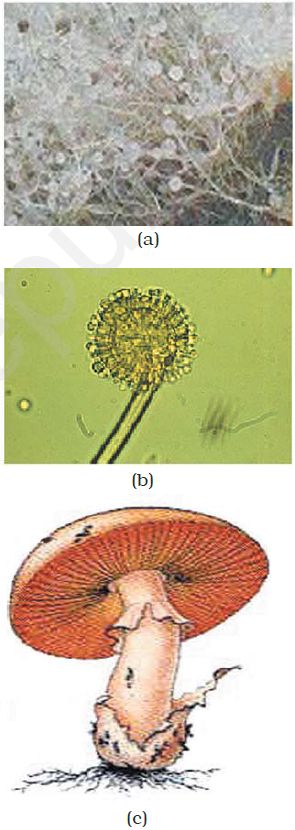
Kingdom Fungi
 المؤلف:
National Council of Educational Research and Training
المؤلف:
National Council of Educational Research and Training
 المصدر:
Biology
المصدر:
Biology
 الجزء والصفحة:
الجزء والصفحة:
 29-1-2021
29-1-2021
 2965
2965
Kingdom Fungi
The fungi constitute a unique kingdom of heterotrophic organisms. They show a great diversity in morphology and habitat. When your bread develops a mould or your orange rots it is because of fungi. The common mushroom you eat and toadstools are also fungi. White spots seen on mustard leaves are due to a parasitic fungus. Some unicellular fungi, e.g., yeast are used to make bread and beer. Other fungi cause diseases in plants and animals; wheat rust-causing Puccinia is an important example. Some are the source of antibiotics, e.g., Penicillium. Fungi are cosmopolitan and occur in air, water, soil and on animals and plants. They prefer to grow in warm and humid places. Have you ever wondered why we keep food in the refrigerator ? Yes, it is to prevent food from going bad due to bacterial or fungal infections.
With the exception of yeasts which are unicellular, fungi are filamentous. Their bodies consist of long, slender thread-like structures called hyphae. The network of hyphae is known as mycelium. Some hyphae are continuous tubes filled with multinucleated cytoplasm – these are
called coenocytic hyphae. Others have septae or cross walls in their hyphae. The cell walls of fungi are composed of chitin and polysaccharides.
Most fungi are heterotrophic and absorb soluble organic matter from dead substrates and hence are called saprophytes. Those that depend on living plants and animals are called parasites. They can also live as symbionts – in association with algae as lichens and with roots of higher plants as mycorrhiza.
Reproduction in fungi can take place by vegetative means –fragmentation, fission and budding. Asexual reproduction is by spores called conidia or sporangiospores or zoospores, and sexual reproduction is by oospores, ascospores and basidiospores. The various spores are produced in distinct structures called fruiting bodies. The sexual cycle involves the following three steps:
(i) Fusion of protoplasms between two motile or non-motile gametes called plasmogamy.
(ii) Fusion of two nuclei called karyogamy.
(iii) Meiosis in zygote resulting in haploid spores.
When a fungus reproduces sexually, two haploid hyphae of compatible mating types come together and fuse. In some fungi the fusion of two haploid cells immediately results in diploid cells (2n). However, in other fungi (ascomycetes and basidiomycetes), an intervening dikaryotic stage (n + n, i.e., two nuclei per cell) occurs; such a condition is called a dikaryon and the phase is called dikaryophase of fungus. Later, the parental nuclei fuse and the cells become diploid. The fungi form fruiting bodies in which reduction division occurs, leading to
formation of haploid spores.
The morphology of the mycelium, mode of spore formation and fruiting bodies form the basis for the division of the kingdom into various classes.

Figure 1 Fungi: (a) Mucor (b) Aspergillus (c) Agaricus
1. Phycomycetes
Members of phycomycetes are found in aquatic habitats and on decaying wood in moist and damp places or as obligate parasites on plants. The mycelium is aseptate and coenocytic. Asexual reproduction takes place by zoospores (motile) or by aplanospores (non-motile). These spores are endogenously produced in sporangium. A zygospore is formed by fusion of two gametes. These gametes are similar in morphology (isogamous) or dissimilar (anisogamous or oogamous). Some common examples are Mucor (Figure 1a), Rhizopus (the bread mould mentioned earlier) and Albugo (the parasitic fungi on mustard).
2. Ascomycetes
Commonly known as sac-fungi, the as comycetes are mostly multicellular, e.g., Penicillium, or rarely unicellular, e.g., yeast (Saccharomyces). They are saprophytic, decomposers, parasitic or coprophilous (growing on dung). Mycelium is branched and septate. The asexual spores are conidia produced exogenously on the special mycelium called conidiophores. Conidia on germination produce mycelium. Sexual spores are called ascospores which are produced endogenously in sac like asci (singular ascus). These asci are arranged in different types of fruiting bodies called ascocarps.
Some examples are Aspergillus (Figure 1b), Claviceps and Neurospora. Neurospora is used extensively in biochemical and genetic work. Many members like morels and buffles are edible and are considered delicacies.
3. Basidiomycetes
Commonly known forms of basidiomycetes are mushrooms, bracket fungi or puffballs. They grow in soil, on logs and tree stumps and in living plant bodies as parasites, e.g., rusts and smuts. The mycelium is branched and septate. The asexual spores are generally not found, but vegetative reproduction by fragmentation is common. The sex organs are absent, but plasmogamy is brought about by fusion of two vegetative or somatic cells of different strains or genotypes. The resultant structure is dikaryotic which ultimately gives rise to basidium. Karyogamy and meiosis take place in the basidium producing four basidiospores. The basidiospores are exogenously produced on the basidium (pl.: basidia). The basidia are arranged in fruiting bodies called basidiocarps. Some common members are Agaricus (mushroom) (Figure 1c), Ustilago (smut) and Puccinia (rust fungus).
4. Deuteromycetes
Commonly known as imperfect fungi because only the asexual or vegetative phases of these fungi are known. When the sexual forms of these fungi were discovered they were moved into classes they rightly belong to. It is also possible that the asexual and vegetative stage have been given one name (and placed under deuteromycetes) and the sexual stage another (and placed under another class). Later when the linkages were established, the fungi were correctly identified and moved out of deuteromycetes. Once perfect (sexual) stages of members of dueteromycetes were discovered they were often moved to ascomycetes and basidiomycetes. The deuteromycetes reproduce only by asexual spores known as conidia. The mycelium is septate and branched. Some members are saprophytes or parasites while a large number of them are decomposers of litter and help in mineral cycling. Some examples are Alternaria, Colletotrichum and Trichoderma.
 الاكثر قراءة في الأحياء العامة
الاكثر قراءة في الأحياء العامة
 اخر الاخبار
اخر الاخبار
اخبار العتبة العباسية المقدسة


